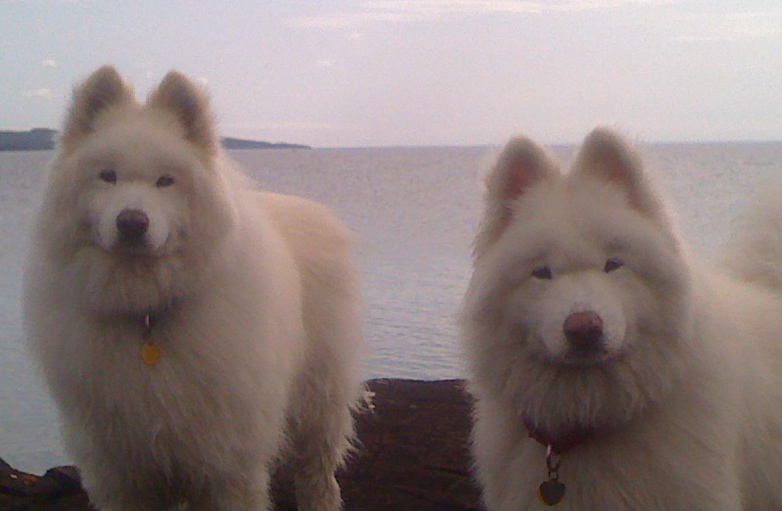If you’re a regular visitor to this web site, we'll assume you enjoy the health benefits, as well as the sensual pleasures, of eating fresh, wholesome, locally grown, sustainably sourced food: real food.
No doubt, you would rebel if someone were to remove all real food from your diet and replace it with a pre-packaged, processed substitute -- a dry cereal, for instance -- as your only source of nutrition.
And yet many of us have at least one beloved family member who eats like this every single day of his or her life.
Kona, left, age 13 and Maui, right, 11. Doesn't your dog – or cat – deserve better?
Why don't more of our pets eat the same quality of food that we eat? And how could Purina, Iams and Eukenuba so easily brainwash us into believing that real food, or "people food," is bad for our dogs and cats?
Consider this: Each day miserable animals visit veterinary offices suffering from skin allergies, digestive problems, arthritis, obesity and cancer. What are they eating? Not real food: dog food.
So what’s wrong with dog food? Here’s a brief background on the dog food industry, from author Michele Welton:
Commercial dog food has only been around since the 1930s when cereal companies were trying to find something to do with their rejected grain -- their wheat and rice and corn that failed USDA inspection because of mold, rancidity, and other contaminants.
They discovered that the meat industry faced the same dilemma. Meat that couldn't pass USDA inspection because it had spoiled or because the livestock was diseased.
The idea of mixing the rejects together and calling it "pet food" was born. Marketing firms were hired to plant this lamentable term in the public's mind, but their product was not then -- nor is it now -- "pet food." It's simply a processed artificial diet created for the benefit of the grain and meat industries and the pet food corporations.
There are plenty of veterinarians who agree:
Dr. Richard Pitcairn, DVM: “The whole concept of Insta-Meal for humans is repulsive. Most people would soon be climbing the walls in frustration, desperate for a salad or some fruit – anything whole and fresh, or just different. Perhaps the thought of eating kibbles for the rest of your own life helps make the point that pets forced to do so are being shortchanged. All of us – humans and animals – should have fresh, wholesome, unprocessed food in our daily diet.”
T.J. Dunn DVM: “In good faith the dog owner assumes that since the dog food label proclaims "complete and balanced,” "premium,” "high protein,” and so on, that their dog will automatically do just great if that's all it is fed. Because of ambiguous or deceptive labeling of the dog food, the owner unknowingly will feed an inadequate diet. And it may be decades before the FDA requires more strict guidelines for dog food manufacturers to follow so that misleading, ambiguous, and sometimes phony labeling practices no longer confuse or trick the purchaser.
Alfred Plechner, DVM: “It's a dinosaur effect. Animals are being programmed for disaster, for extinction.”
In all fairness, some of the newer pet foods are being made with better ingredients and more awareness. I’m happy to report that some the best (see list, below) are made right here in Minnesota and in our next-door neighbor, Wisconsin. These companies do a good job of making dog food with “human-grade” ingredients that are nutritionally balanced, minimally processed and conscientiously manufactured. But they work best when used as a supplement to a real-food diet.
That's what we do. Twice a day, our two dogs get a cup of kibble made by Fromm’s of Wisconsin; to it, we add another cup of a thick puree made from fresh (and local, whenever possible) meats, vegetables and yogurt. (Last week, it was a pureed salad with tomatoes, carrots, chicken, flax oil and ume plum vinegar, plus plain yogurt and fish oil.) We've been doing this for nine years, ever since our holistic vet told us the healthiest things they were eating up to that point were the pizza crusts we shared with them after a visit from Domino’s.
One vet who has done extensive research on the effects of food on a dog’s health, Dr. William Pollak, DVM, claims that 75 percent of commons diseases in dogs and 63 percent of common diseases in cats "can be eliminated without medical intervention over a period of one year with proper diet modifications.”
I'll let Dr. Martin Goldstein, DVM sum it up: “You can profoundly improve your pet's health by making one simple decision. Change her diet from commercial-brand so-called pet food to something you may never have imagined feeding her: real food. The fresh, wholesome -- not processed -- food you buy for yourself is the food you should also feed to your dog or cat.”
Here are some additional resources to get you started:
SF Gate: Real Food for Dogs is Easier Than You Think
http://www.sfgate.com/cgi-bin/article.cgi?f=/g/a/2007/02/07/petscol.DTL
AlterNet: Why is the Pet Food Industry Killing Our Pets
http://www.alternet.org/healthwellness/54236/
DogAware.com
http://www.dogaware.com/dogfeeding.html#commercial
Furoshnikov’s Formulas
http://cookforyourdog.com/
Stella and Chewy’s
http://www.stellaandchewys.com/
Sojos’s
http://www.sojos.com/
Evolution Diet
http://www.petfoodshop.com/index.cfm?id=1230357&fuseaction=browse&pageid=1
Fromm
http://www.frommfamily.com/
Paw Naturaw
http://pawnaturaw.com/
Nature’s Menu
http://www.naturesmenu.com/site/493564/page/45031



